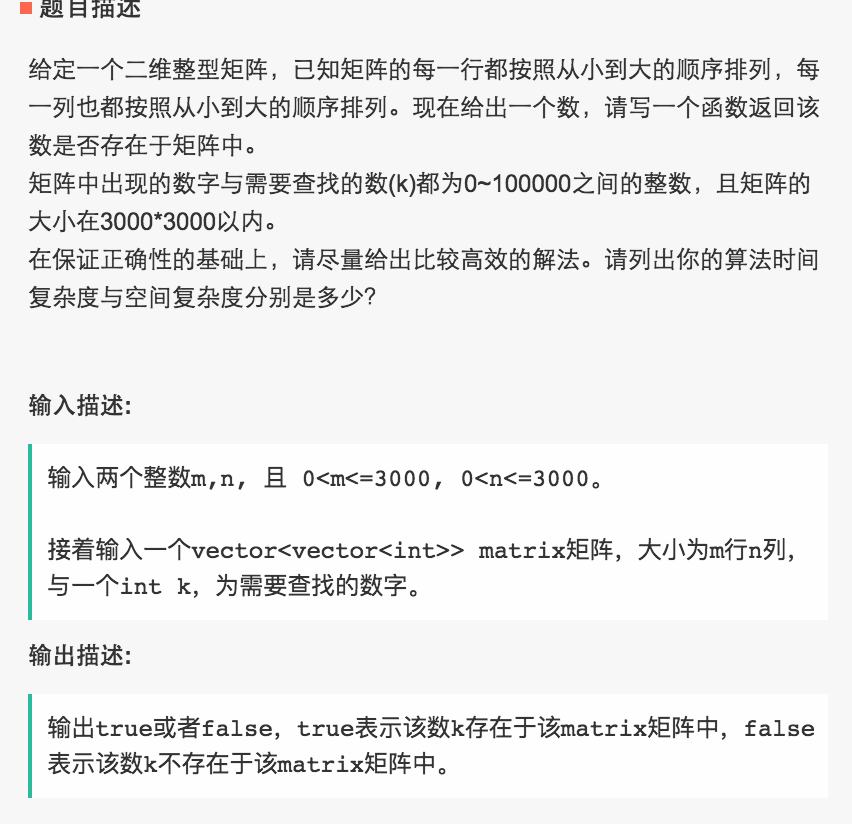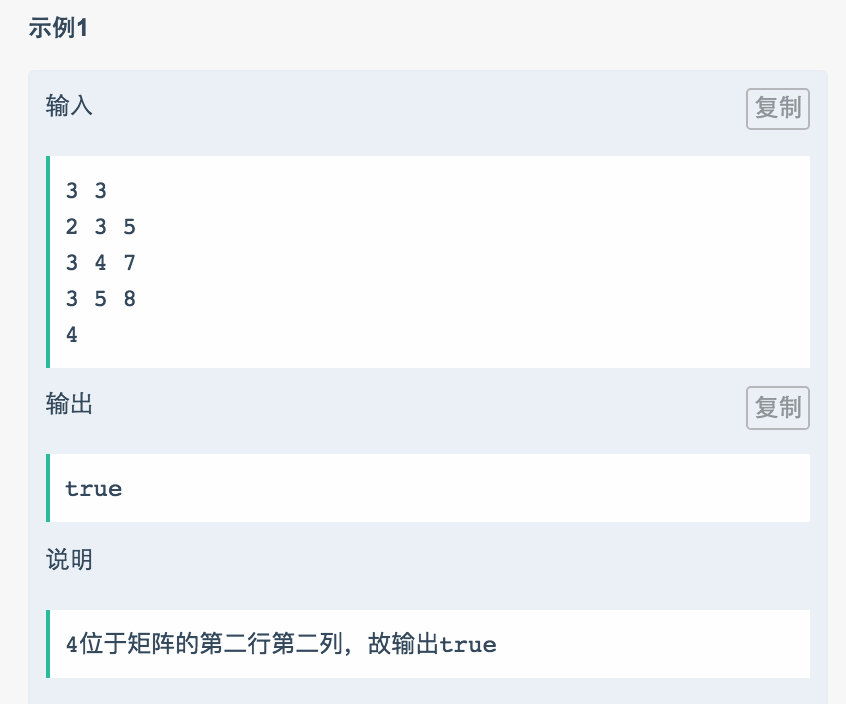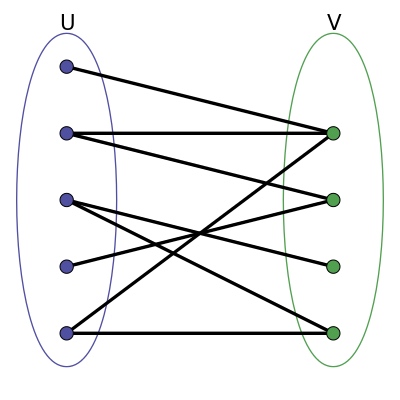第四范式笔试
第一题
 

 

Example:
Consider the following matrix:
[
[1, 4, 7, 11, 15],
[2, 5, 8, 12, 19],
[3, 6, 9, 16, 22],
[10, 13, 14, 17, 24],
[18, 21, 23, 26, 30]
]
Given target = 5, return true.
Given target = 20, return false.
// T(n) = O(m+n)
// S(n) = O(1)
class Solution {
public:
bool searchMatrix(vector<vector<int>>& matrix, int target) {
int m = matrix.size();
if (m == 0) return false;
int n = matrix[0].size();
int i = 0, j = n - 1;
while (i < m && j >= 0) {
if (matrix[i][j] == target)
return true;
else if (matrix[i][j] > target) {
j--;
} else
i++;
}
return false;
}
};
第二题
二部图概念
 

二分图又称双分图、二部图、偶图,指顶点可以分成两个不相交的集 U 和 V, U, V 皆为独立集(independent sets),使得在同一个集内的顶点不相邻(没有共同边)的图。
二分图又称作二部图,是图论中的一种特殊模型。 设 G=(V,E) 是一个无向图,如果顶点 V 可分割为两个互不相交的子集 (U, V),并且图中的每条边 (i, j) 所关联的两个顶点 i 和 j 分别属于这两个不同的顶点集 \(i \in U\), \(j \in V\),则称图 G 为一个二分图。
可以将 U 和 V 当做着色图
U 中所有节点为蓝色, V 中所有节点着绿色,每条边的两个端点的颜色不同,符合图着色问题的要求。相反,用这样的着色方式对非二分图是行不通的,根据三角关系:其中一个顶点着蓝色并且另一个着绿色后,三角形的第三个顶点与上述具有两个颜色的顶点相连,无法再对其着蓝色或绿色(即非二分图, 存在一个顶点既属于 U, 又属于 V)。
解题思路
根据二分图的特性,一条边上的两个点,肯定是属于不同的组。如果它们出现在同一个组中,肯定就不是二分图了。
怎么判断,一条边上的两个点,分属于不同的组呢?
我们需要遍历图,如果找到一条边,两个节点,都在同一组,则不是二分图;如果图遍历完成之后,没有找到这样的边,则是二分图。我们在遍历的过程中,我们需要区分,一条边的两个节点分属于不同的组,这里我们用到了染色法。
核心思想如下:
从某一个点开始,将这个节点染色为白色,并且开始广度优先遍历,找到与其相邻的节点,如果是二分图,相邻节点的颜色都应该不同。如果是黑色,则不变;如果是无色,则染成黑色;如果是白色,也就是同色,程序退出。当图遍历完毕时,没有相邻节点同色的,则是二分图,标记为白色和黑色的两组就是一个划分。
 

input:
5 6
1 2
2 3
3 4
4 1
4 5
5 2
output:
Yes
input:
5 4
1 2
2 3
3 1
4 5
output:
No
解释: 有三角形存在.
#include <queue>
#include <iostream>
using namespace std;
bool isBipartiteGraph(vector<vector<int>> &mygraph,
vector<int> &color, int vertex) {
int n = mygraph.size();
queue<int> vertexes;
vertexes.push(vertex);
// 对于还未被染色 vertex, 设置为 1 或者为 0 都可以, 这是由于该 vertex 已经在第二个连通图中
// 如果 vertex 还在之前的连通图中的话,
// 那么该 vertex 一定会被遍历, 所以该 vertex 不在之前的连通图中.
color[vertex] = 1;
while(!vertexes.empty()) {
int from = vertexes.front();
vertexes.pop();
for(int to = 0; to < n; to++) {
if(mygraph[from][to]) {
if (color[to] == -1) {
vertexes.push(to);
color[to] = !color[from]; //染成不同的颜色, 使用!求反, 很骚气
} else if (color[from] == color[to]) {
//颜色有相同,则不是二分图
return false;
}
}
}
}
return true;
}
int main() {
int num_vertex, num_edge;
cin >> num_vertex >> num_edge;
vector<vector<int>> adjMatrix(num_vertex, vector<int>(num_vertex));
vector<int> color(num_vertex, -1);
int u, v;
for(int i = 0; i < num_edge; i++) {
cin >> u >> v;
u -= 1;
v -= 1;
adjMatrix[u][v] = adjMatrix[v][u] = 1;
}
bool isBipartite = true;
for(int i = 0; i < num_vertex; i++)
// 如果该节点还未被遍历
if(color[i] == -1 ) {
if (!isBipartiteGraph(adjMatrix, color, i)) {
isBipartite = false;
break;
}
}
if (isBipartite) cout << "Yes" <<endl;
else cout << "No" <<endl;
return 0;
}


 浙公网安备 33010602011771号
浙公网安备 33010602011771号